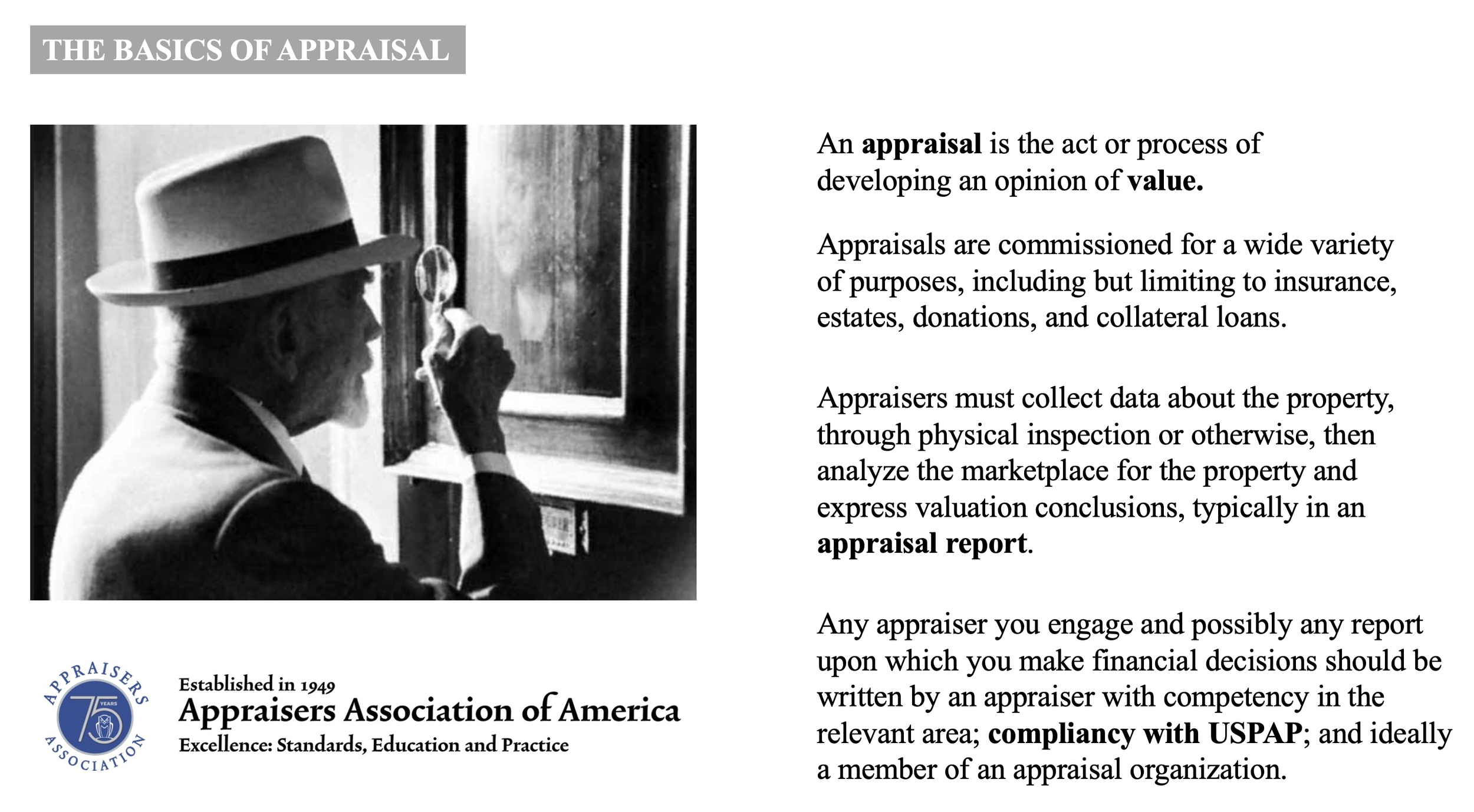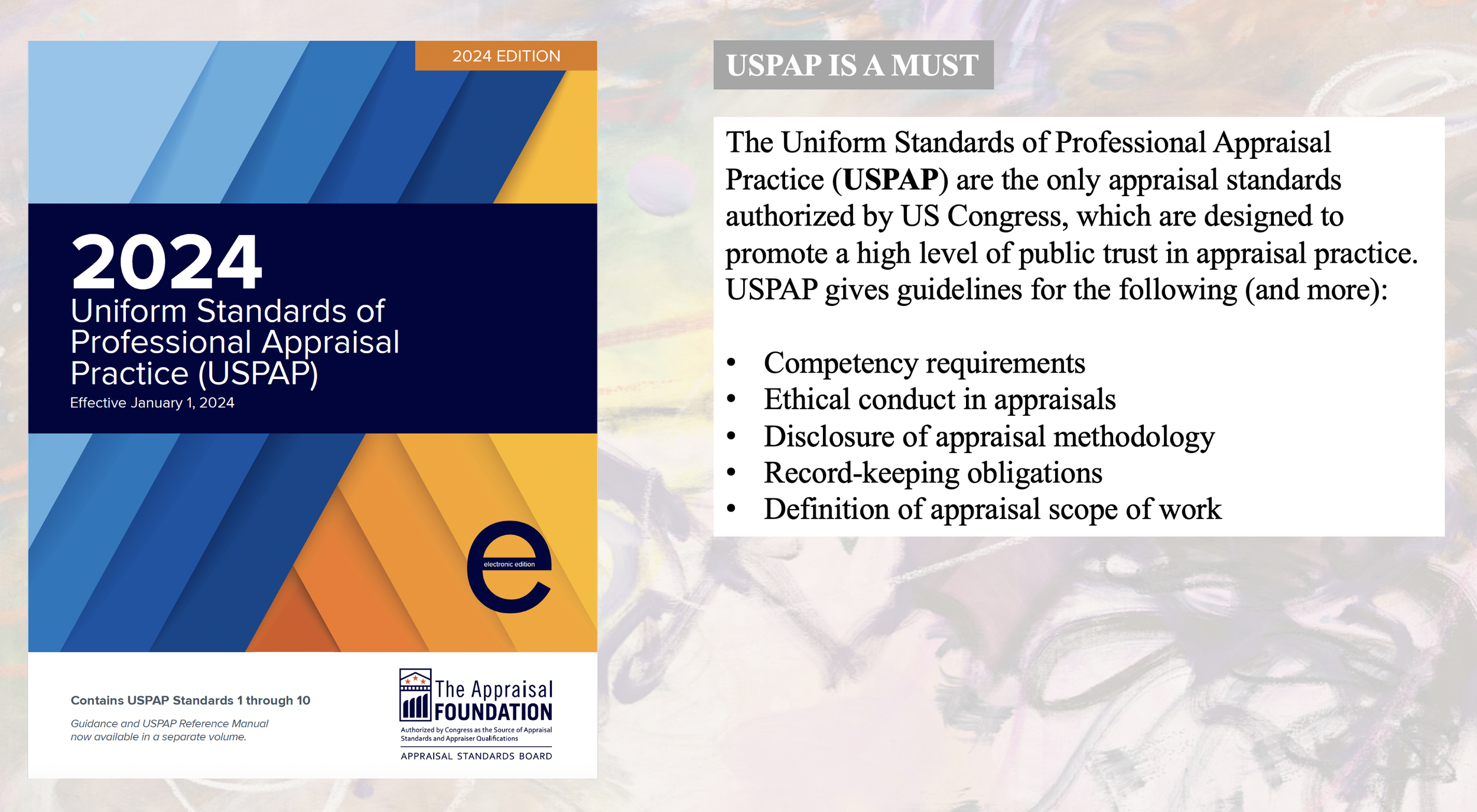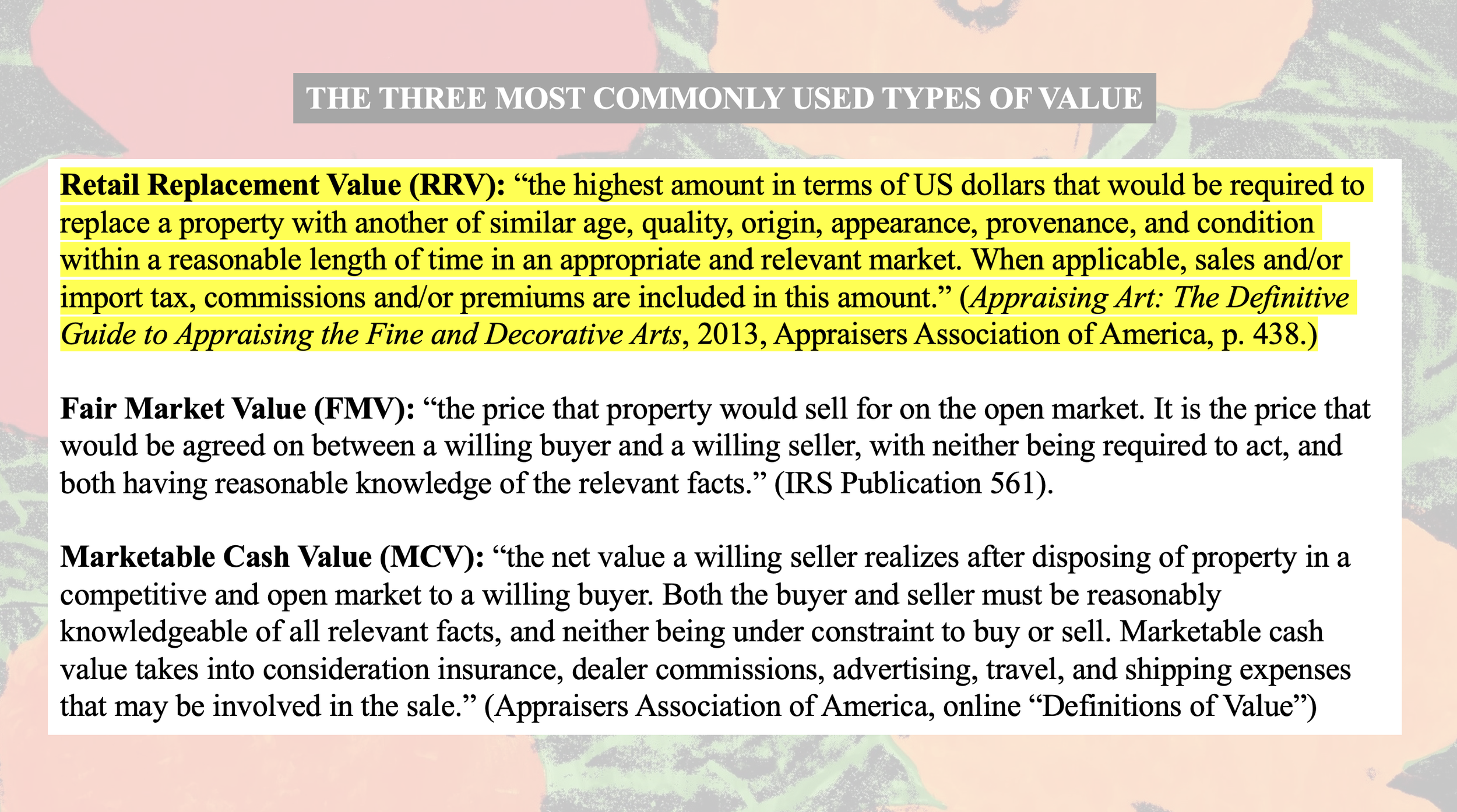Thank you to Private Risk Management Association (PRMA) for hosting a webinar that I led yesterday, "The Art Market, Appraisals, and Insurance: What Brokers Need to Know Now." The presentation was a 50/50 talk, first a bird's eye view of the current art market, then a "nuts and bolts" discussion about some of the most salient aspects of art appraisals for insurance purposes.
A few takeaways for brokers and underwriters:
1. Appraisers whom you or your insureds engage should be USPAP-complaint, competent in the relevant area(s), and ideally hold membership in one of the major appraisal organizations such as the Appraisers Association of America.
2. USPAP (the only appraisal standards authorized by US Congress) comprise a set of requirements and guidelines designed to ensure impartial, objective, independent appraisals, with certain baselines established for diligence, methodological thoroughness, record keeping, ethical conduct, and reporting.
3. There are different types of value. The same work of art will have a different valuation depending on the *type* of value.
4. For insurance scheduling purposes, your insureds should commission appraisals that assess Retail Replacement Value, which is defined as “the highest amount that would be required to replace a property with another of similar age, quality, origin, appearance, provenance, and condition within a reasonable length of time in an appropriate and relevant market.”
5. There is no net relationship between the types of value, especially between Fair Market Value and Retail Replacement Value. This depends enormously on the type of art in question. For some works, the difference between FMV and RRV may be 20%, and for other works, it may be 10x.
6. There is no set timeline for when to reappraise art. This depends on the type of art. For example, a collection of emerging art should probably be considered for reappraisal for insurance purposes more frequently than a collection of traditional American art.
Comments in ARTnews on Cecily Brown
My comments on this week's auction offerings of Cecily Brown paintings are included in Daniel Cassady's article for ARTnews, "Christie's 21st-Century Evening Sale Totals $123.6 M. and Sets a Few Records" about last night's sale:
Most surprising perhaps was Cecily Brown’s It’s not yesterday anymore, which received three bids before auctioneer Yü-Ge Wang—who took over for Meyer after the Edlis-Neeson lots were complete—pulled the work.
As art adviser and appraiser David Shapiro reminded ARTnews after the sale, Brown’s record was reset on Tuesday evening at Sotheby’s after a 10-minute showdown brought High Society (1997–98) from a starting bid of $4 million to a total of $9.8 million. “Market buoyancy notwithstanding, this example suggests that discernment with respect to quality may be a lesson preserved, at least in the meantime, from the last two years,” Shapiro said of Wednesday evening’s pass on It’s not yesterday anymore.
November 2025: High end of the auction market in New York
When it rains, it pours. After a dry spring season in which no works sold above $50M in the marquee sales, and only two (the Monet and Mondrian) sold above $40M (plus the Canaletto six weeks later), the fall auctions are looking very different, with 9 lots poised to sell in this territory or above.
At Sotheby's, the three Klimt paintings have "estimates on request," respectively, of $150M+ for the portrait, and $70M+ and $80M+ for the two landscapes. The Kahlo is estimated at $40-60M, and the Basquiat at $35-$45M.
Christie's has the Rothko with an "estimate on request" in the region of $50M, the Monet at $40-60M, and the Picasso and the Hockney each estimated in the region of $40M (plus there's an exemplary, potentially record-breaking Canaletto on preview for a Feb. sale in Classic Week).
It's a given that the November Evening Sale totals will appreciably exceed May 2025 totals, and yet, one must be careful not to over-extrapolate larger market trends from such changes given that the high end is often a supply-driven market segment, with sales totals tied largely to circumstance. Many of these consignments are estate property, the timing of which is beyond control.
WEBINAR: The Art Market, Appraisals, and Insurance
Please join me on December 9th at 1pm for a webinar, “The Art Market, Appraisals, and Insurance: What Brokers Need to Know,” hosted by the Private Risk Management Association (PRMA). Registration here.
Quote in Artsy about auction fees
My comments are included in Maxwell Rabb's article published today in Artsy. The article provides a clear and useful summary of the fees associated with buying and selling art at auction.
My quote is about the vendor's commission:
A seller’s commission is a fee charged to the seller by the auction house for its services. A seller’s commission is usually charged at a rate between 5 and 10 percent.
Seller’s commissions vary from lot to lot depending on an array of factors: the value and desirability of the work, the competitiveness of the consignment, the seller’s relationship with the auction house, and the financial structure of the sale (like guarantees or marketing costs). High-value or prestigious lots often receive lower or waived fees to attract them, while lower-value or riskier works carry higher commissions to cover costs.
“They’re more likely to enforce a seller’s commission on a low-value work,” said Shapiro. “For a high-value piece, they’ll do what they can to get it, since they’re probably competing against other houses.”
Some categories—like design, wine, and online-only sales—carry their own rates. Even within the same auction house, London and New York may apply slightly different terms.
Journalistic irresponsibility re. art valuation (yet again)
While I hesitate to amplify, I find it harder to sit idly in the face of another article touting artificial intelligence as a panacea to art valuation. Moreover, this salacious column is predictably written by someone (Daniel Grant) with no firsthand experience buying, selling, or appraising art, and it is perhaps unsurprisingly riddled with misinformation, inaccuracies, and elisions.
As a small selection:
1. Any responsible mention of the use of AI to authenticate Old Masters should be accompanied by an acknowledgment of its severe limitations and its potential for misattributions and dispute (lest we forget the Raphael episode).
2. Appraisers do not "set prices" -- we set ascribe values. If Mr. Grant does not know the difference, he should not be writing such an article.
3. The statement that "only a small percentage of artworks are sold at public auction" is misleading. A very significant percentage of high-value works of art are sold at auction.
4. Mr. Grant asks how insurers are "supposed to write fine art policies for collections if the appraisers they rely on have little or no access to the prices paid for artworks." It's patently absurd to contend that appraisers have "little or no access" to private realized price data, when in fact it's precisely our job to research and report on such markets. All good appraisers do this -- and insurers know (or should know) to rely on valuations performed by those appraisers. Technology will not help with this.
5. Mr. Grant uncritically quotes an AI professional who says that "A.I. can understand why and when the value of an artist's work changes over time" However, Mr. Grant curiously does not quote a single appraiser. As a reminder, AI is only as good as what it is fed. AI has neither relationships nor private knowledge, nor any real intelligence in making the necessary decisions to such a pursuit as art appraisal.
etc., etc., etc.
Chubb Art Market Update
It was a pleasure and honor to give the 2025 H1 Art Market Update talk to Chubb’s Fine Art team last week. Thank you to Laura Doyle for extending the invitation, which provided an opportunity to reflect just before the fall auction season opens in New York this week.
By many measures, the art market continued to contract significantly in 2024 (e.g., auction totals down 25%, and off by 39% for $10M+ lots), and has remained soft on the whole in 2025, and yet the total picture has been much more complex than this.
Year-to-year comparisons of totals at equivalent auctions are not fully determinative with regard to the health of a market, nor can demand necessarily be wholly assessed given the circumstantial nature of supply, whether from estates or otherwise.
Strong sales in supply-challenged markets such as Old Masters have shown strength when exemplary works have become available (e.g., Canaletto), and we have seen surges in many markets, not least Surrealism (most visibly, Magritte and Carrington), key female artists in various sectors (e.g., Dumas record), and historically undervalued collecting categories such as South Asian postwar and contemporary art, as well as the personal property markets adjacent to art such as Design and collectibles, in which a series of extraordinary records have been set.
As the consignments for November are just being announced, including those at a level not seen in the first half of the year (esp. Klimt), we can begin to forecast what the fall might look like relative to the spring.
(l.) Ernie Barnes, Sugar Shack (1976) on the cover of the Marvin Gaye album, I Want You; Frank Frazetta "Man Ape" (1966) on the cover of Conan by Robert E. Howard, L. Sprague de Camp, and Lin Carter
Heritage Auctions: a record price in the market for illustration
Heritage Auctions just made another extraordinary sale, fetching $13.5M for Frank Frazetta's "Man Ape" (1966), the highest auction price ever realized for a Comic or Fantasy work of art.
In the art market, we're accustomed to the duopoly of Sotheby's and Christie's dominating the field, but it's Heritage where we've recently seen a procession of extraordinary prices at the high end of the non-art market, with records routinely set for collectibles such as sports and entertainment memorabilia.
At one level, this sale of a highly sought-after piece of illustration fits neatly within into the paradigm of recent market surges for personal property with popular cultural meanings, and outside the market for traditionally recognized high art — precisely at a moment when the mainstream art market has shown signs of softening. But this sale also opens onto larger ontological questions about what distinguishes a work of illustration from a piece of fine art.
It's the Frazetta's familiarity from mass reproduction that propelled its price not only to an artist record but to an all-genre record. However, this sale also immediately recalls the sale of Ernie Barnes's "Sugar Shack" (1976) at Christie's for $15.3M in 2022, following a bidding war that catapulted its price 70x above its high estimate and leagues above the price realized for any other work by the artist. Demand for that painting followed from its mass reproduction as an illustration for Marvin Gaye's album "I Want You."
Complicating the picture is the fact that Frazetta takes visual cues from nineteenth-century European academic painting, whereas Barnes draws on the visual language of cartoons — and yet the current marketing and institutional contexts have established the Barnes as a work of fine art and the Frazetta as a comic illustration.
Artsy quote: Inflation and the Art Market
My comments are included in Veena McCoole’s article in Artsy, “How Inflation Impacts the Art Market”:
“Prices may be up, but if money coming in is also up, that doesn’t necessarily mean a downturn in art purchasing for some,” noted art advisor David Shapiro. “People in the market for a Pablo Picasso, perhaps, aren’t as swayed by inflation and day-to-day costs.”
Reginald Marsh, Art Auction, ca. 1940
Chelsea Gallery Walk
It was a pleasure leading the Chelsea gallery in late July for Risk Strategies Company’s summer event, visiting the Robert Indiana and Alicia Kwade exhibitions at Pace Gallery, Carmen Herrera at Lisson Gallery, and William Kentridge at Hauser & Wirth with colleagues in the artist legacy space. It was a great conversation and a memorable day/night.
RRV and FMV: a complex relationship
In 1972, Stephen Weil wrote the Art in America article “Prices-Right On!” in which he commented on the performance of a Parke-Bernet sale relative to pre-sale estimates: “In theory, at least, the top [high] estimate should be somewhat less, perhaps 10 to 20 percent, than the price a gallery would ask for a similar painting or sculpture. (For its higher price, the gallery may provide a range of works from which to choose, a chance to try works at home on approval, guarantees of authenticity, and condition, and even extended payment terms and the right to make a later exchange).”
In many (if not most) market sectors, it is still expected that dealers will command a premium relative to the auction market for similar property, for reasons such as those noted by Weil. The precise ratio, however, which is far from standard, is a constant source of challenge and inquiry for appraisers. The compexity can be highlighted, for example, when an appraiser is assigned to assess both the Retail Replacement Value and the Fair Market Value of works of art.
RRV, as defined by the Appraisers Association of America, is the “highest amount … that would be required to replace a property with another of similar age, quality, origin, appearance, provenance, and condition within a reasonable length of time in an appropriate and relevant market.”
FMV, by contrast, is “the price that property would sell for on the open market. It is the price that would be agreed on between a willing buyer and a willing seller, with neither being required to act, and both having reasonable knowledge of the relevant facts.” (See: IRS Publication 561). [NB: Notwithstanding its source, FMV and this definition of it are commonly used in a variety of non-IRS applications.]
Sometimes the appraiser, when assessing RRV in a market with few or no available relevant comparable retail sales or offerings, must look to the auction market and extrapolate upwards, but the ratio is not necessarily a summary 10-20%, nor is it 30-40% or some other fixed range that can be applied to any property, but rather it is a ratio that is specific to each market.
Speaking broadly, the delta between FMV and RRV for the same object tends to be much smaller at the high end of the value spectrum. For example, a Rothko that sells for $50 million at Sotheby’s might only be privately marketable for slightly more than such a realized auction price. It may well be that a dealer could only reasonably offer that same painting for $55 million, and therefore, in that stratospheric market, RRV may potentially be no more than 10% higher than FMV.
Consider, then, an emerging artist whose works are offered for $20,000 in the primary market. There is ample supply, no secondary retail market, and works that are occasionally offered at auction fetch only $5,000. In such a case such as this, RRV may well be quadruple FMV.
There are innumerable examples, principally at the low end of the market, in which a secondary market price on LiveAuctioneers will only be a small fraction of the original retail price. There are many works with no secondary market history and no ostensible attainable secondary market at all. In all such cases, the difference between RRV and FMV would follow from these variances.
There are also cases in which an appraiser must assess FMV for an artist whose works have never traded in any secondary market but show promise to attain strong prices if they were to be offered. Demand as well as supply in the primary market would be likely to offer insight as to what a secondary market may hold for the artist.
Phillips: A new tiered structure for the buyer's premium
Phillips announced today that they will launch a new tiered buyer’s premium structure by which advance bids (placed over 48 hours before the auction) will have lower fees than those bids placed during the auction or closer to it. Buyer’s premium for non-advance bids in the lowest value tier will be 29%, the highest ever at any of the major auction houses.
The application of preferential fees for advance bidding has a commonality with the principle of the third-party guarantee, by which the guarantor receives a financing fee in exchange for commitment, though financing fees paid to third-party guarantors are negotiable, whereas Phillips’s new tiered BP structure will proceed according to fixed rules.
Auction houses do not publicize whether a guaranteed lot sells to the guarantor or to another party, but since the financing fee paid to the guarantor/successful bidder is reflected in the total amount of buyer’s premium paid (both on the auction house website and on third-party price databases), one can review the hammer price in tandem with the premium price and interpret accordingly.
Similarly, one should expect that Phillips will not publicize whether a lot sells to an advance bidder or to a non-advance bidder. However, when one compares the hammer price with the premium price, one will be able to deduce, for example, by examining whether the latter is 25% or 29% above the former.
Such variances in buyer’s premium underscore the importance for the appraiser of knowing both the hammer price and the premium price. For example, when assessing Marketable Cash Value (MCV), one cannot simply back out a rounded BP from a premium price, because the BP will be subject to fluctuation.
NB: artnet does not publish hammer prices except, occasionally, for lots that do not have reported BP, in which cases they only publish hammer prices.
Fair Warning
Last week Loïc Gouzer announced on social media that his art auction app Fair Warning would no longer submit auction results to Artnet, and that new results will henceforth only be viewable on the Fair Warning platform. He offered no explanation for this decision.
It's important to note the potential disservice that this willful opacity does to the reliability of art market services. While many of us follow the offerings and results of Fair Warning and have general knowledge of what has sold there, it is also reasonable and appropriate to expect that auction sales of significant works of art will be reported on the major third-party price databases such as Artnet and Artprice. Such reporting is part of running an auction venue.
While appraisers and other art market participants frequently have reason to cross-reference auction-house websites for analysis of certain details, it is nonetheless an expectation among us that realized auction prices will be published in the databases to which we subscribe and upon which we rely.
Fair Warning's refusal to submit price results to third-party price databases presents significant risk for errors in valuations. As one example, in November 2024, the all-time auction record for Elizabeth Peyton was set on Fair Warning with the sale of "Blue Liam" for $4,071,000, topping the artist's previous auction record of $2,645,000, also set at Fair Warning, with the sale of "The Age of Innocence" in December 2023. Had these results not been submitted to Artnet, and had someone relied only on the results published in Artnet without assiduously checking Fair Warning's app to see if a Peyton had sold there, that person could have missed the auction record and mistakenly thought that a lower price of $2,470,000 was her all-time record.
This failure to report auction sales results erodes confidence in the art market, and it undermines the one bastion of transparency that we have. Since private sellers have no legal obligation to disclose data about realized sales, we rely on auction data as the major market measure, and we expect it to be transparent and reasonably complete. Fair Warning has only made slightly over 50 sales to date. When their sales history grows, so too will this problem.
One can also consider whether the burden should lie at all on the business model of the auction price databases. As customers we pay significant fees to use their services, and we justifiably expect thorough reporting of results. Should there be any expectation that the price databases collect freely available data from an app like Fair Warning that refuses to report results?
Thank you Cheryl Karim and Ellen Hoener Ross of Gallagher for inviting me to speak this week to your young collector group. It was an honor to lead the group, and it was an exciting moment to do so, at the end of The Art Business Conference day, with so many interesting conversations fresh in mind.
The talk dealt with strategies for starting an art collection and navigating the complexities of buying art at galleries and at auction, and caring for a collection.
Among the issues discussed were: 1. defining the parameters of a collection; 2. factors that might signal potential market growth; 3. the relative advantages of buying art at auction vs. in retail contexts, for different types of work; and 4. assembling the right team to help you with your collection, including but certainly not limited to an advisor, an insurance broker, a framer, an appraiser, and logistics experts.
(l. to r.) Pablo Picasso, Femme hurlant sa douleur, June 1937, Paul Coulon booth; René Magritte, Moralité du sommeil, ca. 1941, Paul Coulon booth; Gustav Klimt, Prince William Nii Nortey Dowuona, 1897, Wienerroither & Kohlbacher booth: all at TEFAF, New York, 2025
Comments in May edition of Artsy Insider newsletter
Thanks to Artsy Art Market Editor Arun Kakar for including my comments in the May edition of the Artsy Insider newsletter, released today. Here’s my contribution:
Artsy: For this month’s mailbag, we spoke to the independent art advisor David Shapiro. Based in New York, Shapiro is also a certified fine art appraiser and specializes in post-war and contemporary art.
How would you characterize the sentiment at this year’s New York Art Week?
DS: While I hesitate to characterize the sentiments of others, some may agree with my observations, which include the following: At Frieze, some galleries appeared to devote less to this fair than to others.
The compression of New York’s fair schedule into a single week highlighted a palpable difference in quality between Frieze and TEFAF, the latter being superior. As to the question of the extent to which larger economic factors may (or may not) be affecting commerce, one rarely knows the true volume of trade and actual extended prices in a retail sales venue.
As such, the more reliable market gauge, as usual, will be the auctions, after which sentiment will be rooted more firmly in fact.



























